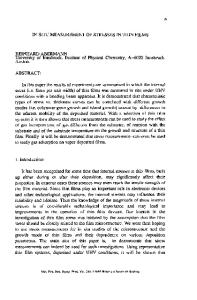Stresses in Multilayered Thin Films
- PDF / 1,419,563 Bytes
- 5 Pages / 604.8 x 806.4 pts Page_size
- 97 Downloads / 376 Views
(1)
where 9 is the Bragg angle. Equal rocking angles produce equivalent D values for uniform curvature, or varied D values for nonuniform curvature. Using this procedure, detailed contour maps of the
34
angular displacement field of the crystal can be mapped in two dimensions. 1 6 1 7 The strain State can be determined from the displacement field and the stress State can be deduced using Standard elasticity. This technique is known as double-crystal diffraction topography (DCDT) and has a sensitivity of one part in 107 in measuring crystal curvature. 518 DCDT can be used to make thin-film stress measurements if the curved crys tal is the Substrate upon which the film is deposited. Laser optical m e t h o d s , both one-dimensional9-11 and twodimensional, 19 are also capable of making stress measurements of similar resolution. Optical methods are more readily employed for in situ evaluations but may have difficulty properly assessing curvatures when the film surface is not "flat."20 It is important to note that in Order to get accurate stress values, it should not be assumed a priori that the bare Substrate is unstrained. Instead, the difference in the curvature of the Substrate before and after deposition must be measured, and the stress in the film is computed using the Stoney equation: o- = Esd2 (1/R ~ 1/R0)/6(1 - vj t,
directly measure the film behavior but instead measure the displacement field imposed on the Substrate by the film stress. Recently techniques have been developed that directly evaluate the displacements in the film, independent of the nature of the Substrate. These meth ods use diffraction techniques to meas ure lattice spacing within the grains of a thin-film sample. An example of this type of approach involves convergentbeam electron diffraction employing a transmission electron microscope. 22 Although this approach is very accurate, it is necessary to recognize that the stress State may be affected by the preparation of samples for the electron microscope. Another method that directly investigates the film behavior, and is nondestruetive, uses grazing angle ineidence x-ray scattering (GIXS).23"37 Both Sym metrie (in which the angle of the reflected beam a r is approximately equal to the angle of the incident beam oti) and asymmetric (in which ar is not equal to
Data Loading...











